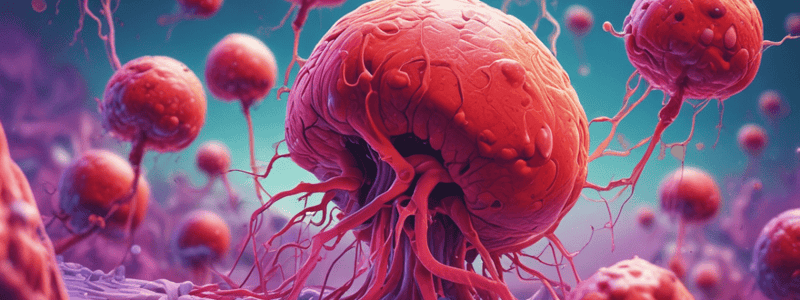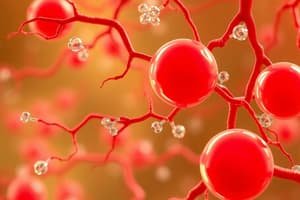Podcast
Questions and Answers
What is the primary cause of hepatocyte swelling or hydropic change?
What is the primary cause of hepatocyte swelling or hydropic change?
- Excessive production of heme leading to accumulation of bilirubin
- Lytic necrosis leading to hepatocyte swelling and rupture
- Impaired bile flow causing obstructive jaundice
- Abnormality in the potassium-sodium pump leading to water retention (correct)
Which type of jaundice is characterized by the accumulation of bilirubin in the brain, causing neurological complications?
Which type of jaundice is characterized by the accumulation of bilirubin in the brain, causing neurological complications?
- Unconjugated bilirubin jaundice
- Conjugated bilirubin jaundice
- Obstructive jaundice
- Kernicterus (correct)
Which of the following is a characteristic of conjugated bilirubin?
Which of the following is a characteristic of conjugated bilirubin?
- Cannot be excreted in urine
- Free form is toxic
- Water-insoluble and tightly complexed to serum albumin
- Water-soluble and loosely bound to serum albumin (correct)
Which of the following liver function tests specifically measures the level of conjugated bilirubin?
Which of the following liver function tests specifically measures the level of conjugated bilirubin?
Which type of necrosis is characterized by poorly staining, mummified hepatocytes?
Which type of necrosis is characterized by poorly staining, mummified hepatocytes?
Which liver function test is used to assess the integrity of hepatocytes?
Which liver function test is used to assess the integrity of hepatocytes?
Which of the following is NOT a characteristic of hepatocellular carcinoma (HCC) mentioned in the text?
Which of the following is NOT a characteristic of hepatocellular carcinoma (HCC) mentioned in the text?
Which of the following is the BEST predictor of prognosis for individuals with HCC?
Which of the following is the BEST predictor of prognosis for individuals with HCC?
What is the median survival time for individuals with HCC, as mentioned in the text?
What is the median survival time for individuals with HCC, as mentioned in the text?
Which of the following is the BEST way to prevent HCC in regions endemic for hepatitis B virus (HBV) infection, according to the text?
Which of the following is the BEST way to prevent HCC in regions endemic for hepatitis B virus (HBV) infection, according to the text?
What is the MAIN difference between HCC and extrahepatic spread, as mentioned in the text?
What is the MAIN difference between HCC and extrahepatic spread, as mentioned in the text?
What is the MAIN cause of death in individuals with HCC?
What is the MAIN cause of death in individuals with HCC?
Which enzyme is present in the biliary epithelium?
Which enzyme is present in the biliary epithelium?
What is a characteristic complication of cholestasis?
What is a characteristic complication of cholestasis?
Which liver function test is specifically mentioned to increase in levels affecting the central nervous system?
Which liver function test is specifically mentioned to increase in levels affecting the central nervous system?
What is a histological feature of liver cirrhosis?
What is a histological feature of liver cirrhosis?
What type of liver injury leads to hepatocyte swelling and foamy degeneration?
What type of liver injury leads to hepatocyte swelling and foamy degeneration?
What is a common complication associated with cholestasis?
What is a common complication associated with cholestasis?
Which of the following is NOT a cause of parenchymal nodules?
Which of the following is NOT a cause of parenchymal nodules?
What is the approximate percentage of cases of cryptogenic cirrhosis?
What is the approximate percentage of cases of cryptogenic cirrhosis?
Which of the following is NOT involved in the pathogenesis of cirrhosis?
Which of the following is NOT involved in the pathogenesis of cirrhosis?
What is the characteristic feature of micronodular cirrhosis?
What is the characteristic feature of micronodular cirrhosis?
Which of the following is a clinical feature of cirrhosis?
Which of the following is a clinical feature of cirrhosis?
What is the characteristic feature of macronodular cirrhosis?
What is the characteristic feature of macronodular cirrhosis?
What is the most common gross appearance of fibrolamellar hepatocellular carcinoma?
What is the most common gross appearance of fibrolamellar hepatocellular carcinoma?
What is the most significant microscopic feature that distinguishes hepatocellular carcinoma from normal liver tissue?
What is the most significant microscopic feature that distinguishes hepatocellular carcinoma from normal liver tissue?
What is the typical microscopic appearance of cholangiocarcinoma?
What is the typical microscopic appearance of cholangiocarcinoma?
Which of the following is a characteristic feature of the fibrolamellar variant of hepatocellular carcinoma?
Which of the following is a characteristic feature of the fibrolamellar variant of hepatocellular carcinoma?
What is the most common gross appearance of a typical hepatocellular carcinoma?
What is the most common gross appearance of a typical hepatocellular carcinoma?
Which of the following is NOT a microscopic feature of hepatocellular carcinoma?
Which of the following is NOT a microscopic feature of hepatocellular carcinoma?
Flashcards are hidden until you start studying




